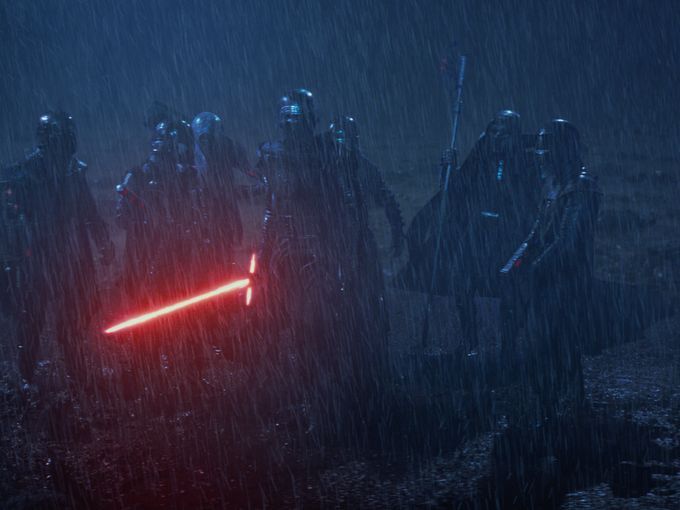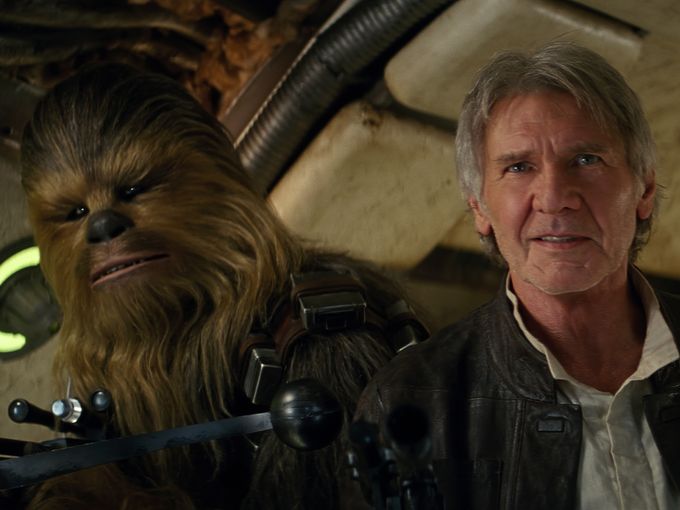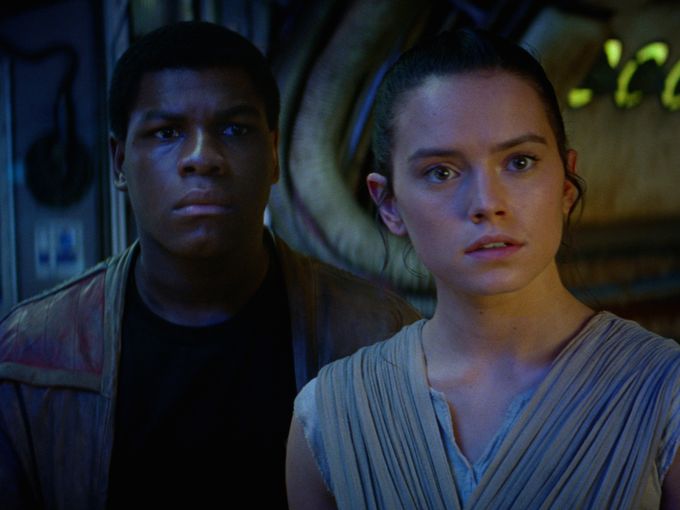A Freedom Fighter on a secret mission is ambushed by stormtroopers and a Villain in a black mask and cape. The Freedom Fighter is forced to entrust vital information to a Cute Droid who bleeps and bloops and who was not designed to go up staircases. The Cute Droid, marooned on a Desert Planet, is saved from thieves by an idealistic young Dreamer who yearns to one day be a fighter pilot for the Revolters. The young Dreamer escapes the Desert Planet in the Millenium Falcon, now joined by Han Solo and Chewbacca. The power of the Weaponized Planet is demonstrated via the explosion of another planet. The Dreamer is given a lightsaber and introduced to the Force by a Wizened Elder—but soon the Dreamer is captured and taken to the Weaponized Planet! Slinking stealthily through the gleaming hallways of the Weaponized Planet, the Dreamer is able to finally escape with the help of Han Solo and Chewbacca. Reconnoitering on a lush Forest Planet, the Revolters, headed by Princess Leia, make plans to destroy the Weaponized Planet. X-wing pilots rush to exploit the Weaponized Planet’s inevitable design flaw. The Dreamer’s new ability to use the Force is instrumental in helping the Revolters blow up the Weaponized Planet moments before it would have blown up the Forest Planet. The Masked Villain escapes the destruction of his fortress. The Revolters have scored a major victory, but their jubilation is dampened by the loss of one of their dearest and most powerful comrades, a Veteran who provided a crucial link to the franchise’s previous trilogy.
This, of course, is the plot of the beloved 1977 film, Star Wars: Episode IV—A New Hope. The film’s remake, Star Wars: The Force Awakens, sticks pretty close to the original—but still some purists are a little upset with liberties taken by the script. For example, the way the X-wings actually fly into the Weaponized Planet to destroy its defenses is much more reminiscent of the destruction of the Weaponized Planet in Episode VI than the destruction of the Weaponized Planet in Episode IV. Also, the Dreamer is a girl instead of a boy. One of the stormtroopers, too, is a girl instead of a boy. One of the stormtroopers takes his helmet off and switches sides, and one of the X-wing pilots talks more than the X-wing pilots in the 1977 original.
to destroy its defenses is much more reminiscent of the destruction of the Weaponized Planet in Episode VI than the destruction of the Weaponized Planet in Episode IV. Also, the Dreamer is a girl instead of a boy. One of the stormtroopers, too, is a girl instead of a boy. One of the stormtroopers takes his helmet off and switches sides, and one of the X-wing pilots talks more than the X-wing pilots in the 1977 original.
Okay, so I’m not the first joyless asshole to buzzkill the public’s elation over the release of a new Star Wars film by pointing out that it’s pretty derivative of the original trilogy. I went into the film as blank-slate as social media would allow me to, and I truly didn’t set out to track all the rehashed plot points—the only real nagging suspicion I carried into the theater was regarding the title. You might remember that a working title for Episode VII was The Ancient Fear, which—although it’s pretty similar to The Phantom Menace—is far better than the utter redundancy of The Force Awakens. Didn’t the Force… um… already awaken? Wasn’t that kind of what happened when Luke tracked down Obi-Wan? They might as well have named it Star Wars: Episode VII—Return of the Reawakening of the Force Again. We have officially found something more culturally disheartening than the oft-ridiculed franchise reboot: a project where the genres of reboot and sequel cannot be distinguished because it is totally built on the hopes that our sense of nostalgia is strong enough to induce widespread amnesia.
Anticipating this review, I imagined that I would focus on how The Force Awakens contributes to America’s anxious history with Star Wars as a political allegory, namely the notion that—as the most powerful country in the world, with corporate, military, and political bases in over one hundred countries—perhaps we are more similar to the Galactic Empire than the ragtag band of freedom fighting Rebels. Even more disconcerting to Americans: how akin are the Force-using, military-base-exploding Rebels to what we label religious terrorists? The media’s nicknaming of Reagan’s proposed Strategic Defense Initiative “Star Wars” has long provided the perfect objective correlative for the prophetic powers of George Lucas’s fantasy world. One major criticism of the prequels is that they tried to force the real-world ramifications that came more naturally to the original trilogy. The prequels were as mired in politics as the Galactic Senate trying to resolve trade blockades and genocide via clone and drone armies. The prequels reached their height of didacticism in two lines ventriloquized into Senator Amidala: “So this is how liberty dies, with thunderous applause,” and “What if the democracy we thought we were serving no longer exists, and the Republic has become the very evil we’ve been fighting to destroy?” When she followed this question with “What this war represents is a failure to listen,” I think we all squirmed in our seats—for several reasons, one of them being the script’s heavy-handedness.
“What if the democracy we thought we were serving no longer exists, and the Republic has become the very evil we’ve been fighting to destroy?” When she followed this question with “What this war represents is a failure to listen,” I think we all squirmed in our seats—for several reasons, one of them being the script’s heavy-handedness.
Because it is such a duplicate of A New Hope, The Force Awakens does not necessarily add to this discussion—though it does refocus our attention on the beloved franchise’s political implications and direct that focus to current events. The First Order’s airstrikes on the desert planet of Jakku nudge our minds towards Syria, especially given the franchise’s fraught representation of desert dwellers with alien Others. “I can’t abide those Jawas,” C-3PO tells Luke in A New Hope, “disgusting creatures!” As much as it can, The Force Awakens sidesteps contemporary political allegorizing, and this might be one of the reasons for its overwhelming success and record-smashing ticket sales in a year we’re particularly invested in a strict delineation between the Light and Dark Sides. It removes the gradations that the prequels tried to explore; most importantly, the overt sendup to Leni Riefenstahl’s glorifications of Nazi power in the scene where General Hux (Domhnall Gleeson) delivers a speech to the stormtroopers allows viewers to safely banish fascist metaphors into conquered history. Of course the stormtroopers being named after Hitler’s Sturmtruppen always did put Star Wars viewers in a Nazi frame of mind, but The Force Awaken’s prominent displays of ruined Empire—Rey living in a downed AT-AT for example—assures us that that Empire, the one that was kind of like us, is a relic of the past, even as it sprouts a new and identical empire from the old. The White House seems satisfied.
However, it’s taken me too long to say: The Force Awakens really is a fun and breathtaking movie. The 135 minutes feels like half that time. The diversity of the cast and the foregrounding of what would normally be stock characters (stormtroopers, X-wing pilots, barkeeps) makes this far, far away galaxy seem utterly contemporary, not such a long time ago after all. Unlike the prequels, in which the talented actors were coerced into stilted performances by hollow dialogue, it’s hard to tell what’s better in The Force Awakens, the acting or the script. The characters actually seem to like one another, the ones who are meant to at least. The use of undercutting humor—especially by the reformed stormtrooper, Finn (John Boyega), and the Resistance’s best pilot, Poe Dameron (Oscar Isaac)—allows us to have our schmaltz and scoff it too. In one short soliloquy and act of betrayal, the seduction of Kylo Ren (Adam Driver) to the Dark Side is more dramatic than the transformation Annakin Skywalker achieved over the spread of three films, even with their lava planets and rife slaughter of children. It was wise not to make Ren’s relationship to Han Solo a big reveal, particularly because we are still waiting to find out the lineage of Rey, a scavenger played by Daisy Ridley (and how she learned to use the Force and wield a lightsaber so quickly—without the extensive training Luke required).
of Kylo Ren (Adam Driver) to the Dark Side is more dramatic than the transformation Annakin Skywalker achieved over the spread of three films, even with their lava planets and rife slaughter of children. It was wise not to make Ren’s relationship to Han Solo a big reveal, particularly because we are still waiting to find out the lineage of Rey, a scavenger played by Daisy Ridley (and how she learned to use the Force and wield a lightsaber so quickly—without the extensive training Luke required).
Although the film’s final scene is a facsimile of the helicopter shot of the lone, robed figure on Skellig Rock at the end of Werner Herzog’s Heart of Glass, the world-weariness of Luke Skywalker (Mark Hamill) realizing he has to re-join the fray is haunting enough to make even the world-weariest Tommy Lee Jones look downright chipper. Since much of the film’s conflict and body count is a result of Luke absenting himself from the Resistance and R2-D2 taking a long nap, Luke’s hinted-at compulsion to exile himself and Daisy’s attempts to reenlist his services will need to be pretty darn compelling in Episode VIII. The rise of the First Order and the mysterious Supreme Leader Snoke (who, like Emperor Palpatine, proves that evil makes you ugly) deflates the original trilogy’s sense of jubilant victory and redemption.
Of course evil had to come back into the galaxy in order for there to be another trilogy, but I admit I’m disappointed that it takes on the identical guise it did under the Galactic Empire. But I regress…
While I admire the diversity of the film’s casting, the way that Disney has so aggressively foregrounded this decision in its marketing of Episode VII—watch any interview with J.J. Abrams—leaves me feeling a little uneasy, as if diversity was a box to be checked in a bureaucratic production process. Although Lucas tried to make Padme a strong character in the prequels, it’s abundantly clear that her main functions are to give birth and die. So it’s important for us to see powerful female and non-white leads in the Star Wars galaxy, but we shouldn’t forget that the real goal should be a filmmaking scene in which corporations can’t use diversity for marketing purposes. Now, if Finn and Poe’s friendship turns into something more—then, I’ll be really impressed.
 So, would I rather have seen a new Star Wars installment that’s really entertaining but a little overly familiar, or something filled with unexpected characters and worlds and twists and turns that I hate? Of course we shouldn’t have to choose—and hopefully, now that the franchise has been reinvigorated, Rian Johnson and everyone involved in Episode VIII will give us a wonderful negotiation between the new and the familiar. But I wouldn’t be surprised if it starts out with the First Order attacking the Resistance’s new base on a Snowy Planet. My main criticism is this: When all nine episodes are done and we’re all debating Disney’s new Kal’Falnl C’ndros spin-off trilogy, I think I’ll look back and feel like Episode VII doesn’t really exist. At least one of nine episodes in this great franchise was sacrificed in order to get us excited again. Everyone was all worked up about online spoilers, but it turns out we had nothing to worry about—we’ve known the plot of The Force Awakens since 1977.
So, would I rather have seen a new Star Wars installment that’s really entertaining but a little overly familiar, or something filled with unexpected characters and worlds and twists and turns that I hate? Of course we shouldn’t have to choose—and hopefully, now that the franchise has been reinvigorated, Rian Johnson and everyone involved in Episode VIII will give us a wonderful negotiation between the new and the familiar. But I wouldn’t be surprised if it starts out with the First Order attacking the Resistance’s new base on a Snowy Planet. My main criticism is this: When all nine episodes are done and we’re all debating Disney’s new Kal’Falnl C’ndros spin-off trilogy, I think I’ll look back and feel like Episode VII doesn’t really exist. At least one of nine episodes in this great franchise was sacrificed in order to get us excited again. Everyone was all worked up about online spoilers, but it turns out we had nothing to worry about—we’ve known the plot of The Force Awakens since 1977.
Still, go see it.
***
Image credits: Featured image, image #2, image #3, image #4, image #5.





One response
Oh my god, thank you. Although I wish I could say I enjoyed The Borscht Awakens as much… I mean, really? Little Darth, brat son of Solo, stomping around in his Halloween costume? As I remember, Vadar had to wear that helmet because he, uh, couldn’t breathe?! And even before that–Solo, after saving the known universe, must revert to selling contraband living creatures to some creep or another? He couldn’t find something better to do? And please: General Laya, all dressed up in LL Bean for her walk through the Maine woods. BECAUSE SHE LOST HER SPUNK! Very disappointing. I wanted my money back. Nearly $20. For THAT.
Click here to subscribe today and leave your comment.